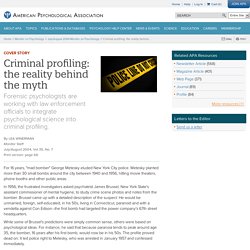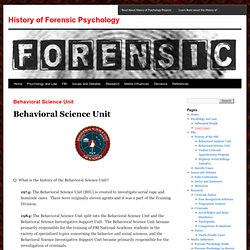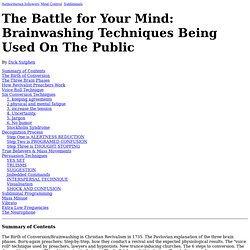

Criminal profiling: the reality behind the myth. For 16 years, "mad bomber" George Metesky eluded New York City police.

Metesky planted more than 30 small bombs around the city between 1940 and 1956, hitting movie theaters, phone booths and other public areas. In 1956, the frustrated investigators asked psychiatrist James Brussel, New York State's assistant commissioner of mental hygiene, to study crime scene photos and notes from the bomber. Brussel came up with a detailed description of the suspect: He would be unmarried, foreign, self-educated, in his 50s, living in Connecticut, paranoid and with a vendetta against Con Edison--the first bomb had targeted the power company's 67th street headquarters. While some of Brussel's predictions were simply common sense, others were based on psychological ideas. For instance, he said that because paranoia tends to peak around age 35, the bomber, 16 years after his first bomb, would now be in his 50s. FBI Behavioral Science Unit Interview - Part 1.
History of Forensic Psychology. Q: What is the history of the Behavioral Science Unit?

1974: The Behavioral Science Unit (BSU) is created to investigate serial rape and homicide cases. There were originally eleven agents and it was a part of the Training Division. 1984: The Behavioral Science Unit split into the Behavioral Science Unit and the Behavioral Science Investigative Support Unit. The Behavioral Science Unit became primarily responsible for the training of FBI National Academy students in the variety of specialized topics concerning the behavior and social sciences, and the Behavioral Science Investigative Support Unit became primarily responsible for the investigation of criminals. 1994: The Critical Incident Response Group integrated the FBI’s crisis management, behavioral, and tactical resources within one entity. 1997: The program then evolved into the Behavioral Analysis Unit.
Q: What is the Behavioral Science Unit? How to Detect Lies - body language, reactions, speech patterns. Interesting Info -> Lying Index -> How to Detect Lies Become a Human Lie Detector (Part 1) Warning: sometimes ignorance is bliss.

After gaining this knowledge, you may be hurt when it is obvious that someone is lying to you. The following deception detection techniques are used by police, forensic psychologists, security experts and other investigators. Introduction to Detecting Lies: Eye Movement and Lying - How to detect lies. Interesting Info -> Lying Index -> Eye Direction & Visual Accessing Cues Eye Movement and Direction & How it Can Reveal Truth or Lies This is a continuation of our previous article Detecting Lies.

Many comments by our visitors asked about how eye direction can indicate the presence of a lie. Can the direction a person's eyes reveal whether or not they are making a truthful statement? Short answer: sort of. How to Detect Lies - body language, reactions, speech patterns. Micro Expressions - Research, Theory & Lying. Interesting Info -> Lying Index & Body Language -> Micro Expressions Is the show "Lie to Me" for real?

I am not a police interrogator, scientist, or other expert... I am however a mother & people watcher. Years ago, when I wrote articles on How to Detect Lies & Eye Movement and Lying -- I knew of the Micro expression theory, but had a difficult time researching the subject well enough to relay it into an article. Recently, I've come across tons of new research, websites, articles, videos, etc. about micro expressions and believe anyone who reads my old articles about lying & body language would benefit from micro expression research and theory. What are Micro Expressions?
A micro expression is a momentary involuntary facial expression -- that people unconsciously display when they are hiding an emotion. The main points to remember are that micro expressions are: Brief - Micro-expressions can appear then disappear off the face in a fraction of a second. . And the Duchenne Smile. Dr. Dr. Dr. Mind -Knowledge. The Battle for Your Mind: Brainwashing Techniques. Authoritarian followers Mind Control Subliminals By Dick Sutphen Summary of Contents The Birth of Conversion The Three Brain Phases How Revivalist Preachers Work Voice Roll Technique Six Conversion Techniques 1. keeping agreements 2.physical and mental fatigue 3. increase the tension 4.

Uncertainty. 5. Jargon 6. No humor Stockholm SyndromeDecognition Process Step One is ALERTNESS REDUCTION Step Two is PROGRAMED CONFUSION Step Three is THOUGHT STOPPINGTrue Believers & Mass Movements Persuasion Techniques YES SET TRUISMS SUGGESTION Imbedded Commands INTERSPERSAL TECHNIQUE Visualisation SHOCK AND CONFUSIONSubliminal Programming Mass Misuse Vibrato Extra Low Frequencies The Neurophone Summary of Contents. Cold Reading.
Wrong facts stick in memory. "Misinformation...continued to influence memory and reasoning.

" Image: flyparade/iStockphoto Humans are taught from an early age to tell the truth so if we realise the facts have been misrepresented, we do our best to set the record straight. But a study from The University of Western Australia found even clear warnings to ignore misinformation can't erase the damage done. The study by Assistant Professor Ullrich Ecker, Professor Stephan Lewandowsky and David Tang, from UWA's School of Psychology, was first published last year in Memory & Cognition journal and is featured this month in another journal Scientific American. Professor Ecker said information that was initially thought to be correct, but later retracted or corrected, often continued to influence memory and reasoning.